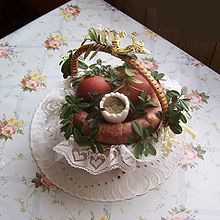Easter food blessing in Poland
The Easter food blessing in Poland ( Polish: Błogosławienie pokarmów wielkanocnych , also Wielkanocne święcenie pokarmów , Latin Benedictio agni et carnium in the Sanctae Paschae ) is a Polish custom on Holy Saturday , in which the Śarrwięconki (the parish church to be blessed) in a Catholic Easter baskets are brought and are blessed there and sprinkled with holy water, before the food is traditionally consumed at Easter breakfast on Easter Sunday with the family.
History and meaning
The blessing of Easter dishes was introduced by the Polish nobility in Poland-Lithuania centuries ago . The whole table and everything that belongs to the Easter breakfast on Easter Sunday was blessed. This cost the pastors a lot of time, which is why the bishops gradually forbade the blessing of food in private homes. Instead, they moved the Blessing to the church. Until the Second World War , the entire breakfast was brought to the church in huge baskets; nowadays you tend to bring a smaller amount with you and later split it up among the family. The breakfast is supplemented by Easter dishes that have not been blessed.
Koszyk (Easter basket)
After the entire breakfast was brought to the church in huge Easter baskets until the Second World War , small koszyk (Easter baskets) have served this purpose since 1945 . The baskets are traditionally decorated with boxwood branches.
Easter dishes that symbolize something specific are placed in the basket:
| Surname | symbol for |
|---|---|
| loaf | Christ as "Bread of Life" |
| Easter eggs | Beginning, new life, resurrection |
|
Easter lamb made of chocolate, butter or dough (some with a flag that says Alleluia ) |
Lamb of God because Jesus Christ humbly accepted his execution as a lamb |
| salt | Purification of hearts, covenant between man and God |
| Sausages | Prosperity and wealth |
| water | Holy Spirit, born again, life |
| horseradish | Bitterness of Christ's sufferings |
These gifts are often varied by the following:
- Baba wielkanocna - symbolizes skill and excellence
- Pepper - like salt, symbolizes the purification of the heart, the bond between man and God
procedure
The rite for the blessing of food can be found in the Benedictine . It is usually performed by the priest or deacon at noon or in the early afternoon on Holy Saturday . The Easter dishes, which are initially wrapped in white towels, are opened in the Koszyk and then sprinkled with holy water . The food blessing can be held outside in the church, near chapels , wayside shrines or wayside crosses .
Distribution and similar customs
According to a statistical survey from 2000, 95% of the Polish population practice this custom. Polish emigrants also brought this custom to the United States. In addition to the Polish parishes in Germany, Easter dishes are also blessed in German and Austrian parishes (here more on Maundy Thursday ), because the custom of blessing food is also known here under the term “ meat consecration ”. The custom also exists in Slovenia .
Web links
Individual evidence
- ↑ Ilona Fudali: An old custom - a blessing for the Easter dish . ( derwesten.de [accessed on November 26, 2017]).



